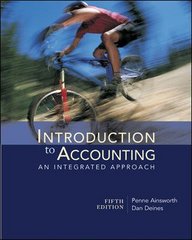Question
Ratios and financial planning at S&S Air Chris Guthrie was recently hired by S&S Air, Inc., to asset the company with its financial planning and
Ratios and financial planning at S&S Air
Chris Guthrie was recently hired by S&S Air, Inc., to asset the company with its financial planning and to evaluate the company's performance.Chris graduated from college five years ago with a finance degree.He has been employed in the finance department of a Fortune 500 company since then.
S&S Air was founded 10 years ago by friends Mark Sexton and Todd Story.The company has manufactured and sold light airplanes over this period, and the company's products have received high reviews for safety and reliability.The company has a niche market in that is sells primarily to individuals who own and fly their own airplanes. The company has two models: the Birdie, which sells for $103,000, and the Eagle, which sells for $178,000
Although the company manufactures aircraft, its operations are different from commercial aircraft companies.S&S Air builds aircraft to order.By using prefabricated parts, the company can complete the manufacture of an airplane in only five weeks.The company also receives a deposit on each order, as well as another partial payment before the order is complete.In contast, a commercial airplane may take one and one-half to two years to manufacture once the order is placed.
Mark and Todd have provided financial statements (which are to the left and below).In addition, Chris has gathered the industry ratios for the light airplance manufacturing industry (below).
2019 Income Statement
Sales $ 40,259,230
COGS 29,336,446
Other expenses 5,105,100
Depreciation 1,804,220
EBIT $4,013,464
Interest 630,520
Taxable income $3,382,944
Taxes (40%) $ 1,353,178
Net income $2,029,766
Dividends $610,000
Add to RE $1,419,766
2019 Balance Sheet
Assets
Liabilities & Equity
Current Assets
Current Liabilities
Cash $456,435
Accounts Payable $929,005 Accounts rec. 733,125
Notes Payable 2,121,350
Inventory 1,073,180
Total CL $ 3,050,355
Total CA $2,262,740
Long-term debt $5,500,000
Shareholder Equity
Fixed assets
Common stock $400,000
Net PP&E $ 17,723,430
Retained earnings 11,035,815
Total Equity $11,435,815 Total Assets $ 19,986,170
Total L&E $19,986,170
Industry
Lower Quartile Median Upper Quartile
Current ratio 0.50 1.43 1.89
Quick ratio 0.21 0.35 0.62
Cash ratio 0.08 0.21 0.39
Total asset turnover 0.68 0.85 1.38
Inventory turnover 4.89 6.15 10.89
Receivables turnover 6.27 9.82 14.11
Total debt ratio 0.44 0.52 0.61
Debt-equity ratio 0.68 1.08 1.56
Equity multiplier 1.68 2.08 2.56
Times interest earned 5.18 8.06 9.83
Cash coverage ratio 5.84 9.41 10.27
Profit margin 4.05% 5.10% 7.15%
Return on assets 6.05% 10.53% 13.21%
Return on equity 9.93% 18.14% 26.15%
Questions
1.Using the financial statements provided above, calculate each of the ratios listed in the industry table for S&S Air (all 14 of them).
2.Mark and Todd agree a ratio analysis can provide a measure of the company's performance.They have chosen Boeing as an aspirant (comparison) company.Would you choose Boeing as an aspirant company?Why or why not?There are other aircraft manufacturers S&S Air could use as aspirant companies.Discuss whether it is appropriate to use any of the following companies: Bombadier, Embraer, Cirrus Aircraft Corporation, and Cessna Aircraft Company.
3.Compare the performance of S&S Air to the industry, using the 14 ratios you calculated in part 1 and the industry table provided.For each ratio, comment on whether it would be viewed as positive or negative (favorable or unfavorable) to the industry and why.
4.calculate each of the ratios listed in the table.Be sure to show your work.
5.Briefly comment on the appropriateness of Boeing and the other competitors as an aspirant company for comparison
6.compare each calculated ratio to the industry ratios given in the table.Briefly explain whether the calculated ratio would be viewed positively or negatively relative to the industry and why.Note it is not enough to simply say whether a particular ratio is higher or lower than the industry.You need to interpret whether the ratio would be viewed favorably or unfavorably, demonstrating your understanding of each ratio.
Step by Step Solution
There are 3 Steps involved in it
Step: 1

Get Instant Access to Expert-Tailored Solutions
See step-by-step solutions with expert insights and AI powered tools for academic success
Step: 2

Step: 3

Ace Your Homework with AI
Get the answers you need in no time with our AI-driven, step-by-step assistance
Get Started


